Polydimethylsiloxanes with Grafted Dibenzoylmethanatoboron Difluoride: Synthesis and Properties
Abstract
:1. Introduction
2. Experimental
2.1. Materials
2.1.1. Synthesis of Polysiloxane with Distributed SiH Groups (1 a,b)
2.1.2. Synthesis of Polysiloxane with Distributed DBMBF2 Groups (3 a,b)
2.2. Characterization
3. Results and Discussion
3.1. Preparation
3.2. Characterization
3.3. TGA, DSC and TMA Analysis
3.4. Rheological Properties
3.5. Optical Properties
4. Conclusions
Supplementary Materials
Author Contributions
Funding
Institutional Review Board Statement
Informed Consent Statement
Data Availability Statement
Acknowledgments
Conflicts of Interest
References
- Tegge, G. Volume B 4: Principles of Chemical Reaction Engineering and Plant Design. In Ullmann’s Encyclopedia of Industrial Chemistry, 5th ed.; VCH Verlagsgesellschaft mbH: New York, NY, USA, 1993; Volume 45, p. 201. ISBN 3-527-20134-3. [Google Scholar] [CrossRef]
- Ren, Z.; Yan, S. Polysiloxanes for optoelectronic applications. Prog. Mater. Sci. 2016, 83, 383–416. [Google Scholar] [CrossRef]
- Su, K.; DeGroot Jr, J.V.; Norris, A.W.; Lo, P.Y. Siloxane Materials for Optical Applications. In ICO20: Materials and Nanostructures; Lu, W., Young, J., Eds.; Proc. SPIE 6029; SPIE: Bellingham, WA, USA, 2006; pp. 318–325. [Google Scholar]
- Gardinier, W.E.; Bright, F.V. Temperature-Dependent Tail−Tail Dynamics of Pyrene-Labeled Poly(dimethylsiloxane) Oligomers Dissolved in Ethyl Acetate. J. Phys. Chem. B 2005, 109, 14824–14829. [Google Scholar] [CrossRef]
- Rossi, N.A.A.; Duplock, E.J.; Meegan, J.; Roberts, D.R.; Murphy, J.J.; Patel, M.; Holder, S.J. Synthesis and characterisation of pyrene-labelled polydimethylsiloxane networks: Towards the in situ detection of strain in silicone elastomers. J. Mater. Chem. 2009, 19, 7674. [Google Scholar] [CrossRef] [Green Version]
- Kumar, A.; Pandey, M.K.; Anandakathir, R.; Mosurkal, R.; Parmar, V.S.; Watterson, A.C.; Kumar, J. Sensory response of pegylated and siloxanated 4,8-dimethylcoumarins: A fluorescence quenching study by nitro aromatics. Sens. Actuators B Chem. 2010, 147, 105–110. [Google Scholar] [CrossRef]
- Pakhomov, A.A.; Mironiuk, V.B.; Kononevich, Y.N.; Korlyukov, A.A.; Volodin, A.D.; Pryakhina, T.A.; Martynov, V.I.; Muzafarov, A.M. Synthesis and crystal structure of a meso -decene-BODIPY dye as a functional bright fluorophore for silicone matrices. Mendeleev Commun. 2017, 27, 363–365. [Google Scholar] [CrossRef]
- Ogi, S.; Sugiyasu, K.; Takeuchi, M. Synthesis of a Doubly Strapped Light-Harvesting Porphyrin Bearing Energy Donor Molecules Hanging on to the Straps: An Attempt toward Macroscopic Control over Molecular Conformation that Affects the Efficiency of Fluorescence Resonance Energy Transfer. Bull. Chem. Soc. Jpn. 2011, 84, 40–48. [Google Scholar] [CrossRef] [Green Version]
- Kim, E.E.; Kononevich, Y.N.; Dyuzhikova, Y.S.; Ionov, D.S.; Khanin, D.A.; Nikiforova, G.G.; Shchegolikhina, O.I.; Vasil’ev, V.G.; Muzafarov, A.M. Cross-Linked Luminescent Polymers Based on β-Diketone-Modified Polysiloxanes and Organoeuropiumsiloxanes. Polymers 2022, 14, 2554. [Google Scholar] [CrossRef]
- Wang, N.; Feng, L.; Xu, X.; Feng, S. Dynamic Covalent Bond Cross-Linked Luminescent Silicone Elastomer with Self-Healing and Recyclable Properties. Macromol. Rapid Commun. 2022, 43, 2100885. [Google Scholar] [CrossRef]
- Yang, J.; Wang, T.; Guo, R.; Yao, D.; Guo, W.; Liu, S.; Li, Z.; Wang, Y.; Li, H. Self-Healing Material with Reversible Luminescence Switch Behavior. ACS Appl. Mater. Interfaces 2020, 12, 54026–54034. [Google Scholar] [CrossRef]
- Zhao, D.; Yang, J.; Wang, Y.; Li, H. Luminescent self-healing materials constructed via coordination between lanthanide ions and phenanthroline-tethered to polymer chain. Dye. Pigment. 2022, 197, 109864. [Google Scholar] [CrossRef]
- de Jesus, F.A.; Santana, B.V.; da Cunha Bispo, G.F.; da Silva Filho, C.I.; Júnior, S.A.; Valério, M.E.G.; Caiut, J.M.A.; Sarmento, V.H.V. Fine tuning of polymer content for enhanced structure and luminescent properties of Eu3+: Siloxane–poly (methyl methacrylate) hybrids to be applied in photonics. Polymer 2019, 181, 121767. [Google Scholar] [CrossRef]
- Manzani, D.; Nigoghossian, K.; Iastrensk, M.F.; Coelho, G.R.; dos Santos, M.V.; Maia, L.J.Q.; Ribeiro, S.J.L.; Segatelli, M.G. Luminescent silicone materials containing Eu3+ -complexes for photonic applications. J. Mater. Chem. C 2018, 6, 8258–8265. [Google Scholar] [CrossRef]
- Lai, Q.; Lu, H.; Wang, D.; Wang, H.; Feng, S.; Zhang, J. Color-Tunable Luminescent Materials Based on Functional Polysiloxane and Lanthanide Ions. Macromol. Chem. Phys. 2011, 212, 1435–1442. [Google Scholar] [CrossRef]
- Liang, Y.; Xu, L.; Qu, F.; Tang, K.; Wang, H.; Yu, W.W. A silicone polymer modified by fluoranthene groups as a new approach for detecting nitroaromatic compounds. Polym. Chem. 2019, 10, 4818–4824. [Google Scholar] [CrossRef]
- Basu, B.J.; Rajam, K.S. Comparison of the oxygen sensor performance of some pyrene derivatives in silicone polymer matrix. Sens. Actuators B Chem. 2004, 99, 459–467. [Google Scholar] [CrossRef]
- Gaspar, R.D.; Ferraz, S.M.; Padovani, P.C.; Fortes, P.R.; Mazali, I.O.; Sigoli, F.A.; Raimundo, I.M. Luminescent oxygen probes based on TbIII complexes chemically bonded to polydimethylsiloxane. Sens. Actuators B Chem. 2019, 287, 557–568. [Google Scholar] [CrossRef]
- Feng, M.; Wang, N.; Li, J.; Feng, S.; Xu, X.-D. Facile construction of luminescent silicone elastomers from the compatibilization of porphyrins via the Piers-Rubinsztajn reaction. Colloids Surf. A Physicochem. Eng. Asp. 2022, 642, 128646. [Google Scholar] [CrossRef]
- Lu, H.; Liu, L.; Feng, S. A new way to construct luminescent functionalized polysiloxane based on ternary lanthanide complexes of 1, 10-phenanthroline. J. Appl. Polym. Sci. 2012, 123, 1884–1888. [Google Scholar] [CrossRef]
- Wang, X.; Lu, H.; Wang, H.; Feng, S. Synthesis and photophysical properties of rare earth-containing luminescent silicone resin from cooperative molecular design and assembly. J. Non. Cryst. Solids 2010, 356, 1581–1586. [Google Scholar] [CrossRef]
- Wang, X. Construction and photoluminescence of amorphous silicone resins containing lanthanide ions as luminescent center. J. Non. Cryst. Solids 2012, 358, 765–770. [Google Scholar] [CrossRef]
- Chen, P.-Z.; Niu, L.-Y.; Chen, Y.-Z.; Yang, Q.-Z. Difluoroboron β-diketonate dyes: Spectroscopic properties and applications. Coord. Chem. Rev. 2017, 350, 196–216. [Google Scholar] [CrossRef]
- Tanaka, K.; Chujo, Y. Recent progress of optical functional nanomaterials based on organoboron complexes with β-diketonate, ketoiminate and diiminate. NPG Asia Mater. 2015, 7, e223. [Google Scholar] [CrossRef] [Green Version]
- Loudet, A.; Burgess, K. BODIPY Dyes and Their Derivatives: Syntheses and Spectroscopic Properties. Chem. Rev. 2007, 107, 4891–4932. [Google Scholar] [CrossRef]
- Frath, D.; Massue, J.; Ulrich, G.; Ziessel, R. Luminescent materials: Locking π-conjugated and heterocyclic ligands with boron (III). Angew. Chem. Int. Ed. 2014, 53, 2290–2310. [Google Scholar] [CrossRef]
- Li, D.; Zhang, H.; Wang, Y. Four-coordinate organoboron compounds for organic light-emitting diodes (OLEDs). Chem. Soc. Rev. 2013, 42, 8416–8433. [Google Scholar] [CrossRef]
- Morris, W.A.; Liu, T.; Fraser, C.L. Mechanochromic luminescence of halide-substituted difluoroboron β-diketonate dyes. J. Mater. Chem. C 2015, 3, 352–363. [Google Scholar] [CrossRef]
- Yoshii, R.; Suenaga, K.; Tanaka, K.; Chujo, Y. Mechanofluorochromic materials based on aggregation-induced emission-active boron ketoiminates: Regulation of the direction of the emission color changes. Chem. A Eur. J. 2015, 21, 7231–7237. [Google Scholar] [CrossRef]
- Zhang, Z.; Wu, Z.; Sun, J.; Yao, B.; Zhang, G.; Xue, P.; Lu, R. Mechanofluorochromic properties of β-iminoenolate boron complexes tuned by the electronic effects of terminal phenothiazine and phenothiazine-S,S-dioxide. J. Mater. Chem. C 2015, 3, 4921–4932. [Google Scholar] [CrossRef]
- Sagawa, T.; Ito, F.; Sakai, A.; Ogata, Y.; Tanaka, K.; Ikeda, H. Substituent-dependent backward reaction in mechanofluorochromism of dibenzoylmethanatoboron difluoride derivatives. Photochem. Photobiol. Sci. 2016, 15, 420–430. [Google Scholar] [CrossRef]
- Kononevich, Y.N.; Temnikov, M.N.; Korlyukov, A.A.; Volodin, A.D.; Dorovatovskii, P.V.; Sazhnikov, V.A.; Safonov, A.A.; Ionov, D.S.; Ivanov, A.A.; Surin, N.M.; et al. Tetrahedral Silicon-Centered Dibenzoylmethanatoboron Difluorides: Synthesis, Crystal Structure, and Photophysical Behavior in Solution and the Solid State. ChemPlusChem 2020, 85, 1111–1119. [Google Scholar] [CrossRef]
- Morris, W.A.; Kolpaczynska, M.; Fraser, C.L. Effects of α-Substitution on Mechanochromic Luminescence and Aggregation-Induced Emission of Difluoroboron β-Diketonate Dyes. J. Phys. Chem. C 2016, 120, 22539–22548. [Google Scholar] [CrossRef]
- Louis, M.; García, C.P.; Brosseau, A.; Allain, C.; Métivier, R. Mechanofluorochromism of a Difluoroboron-β-Diketonate Derivative at the Nanoscale. J. Phys. Chem. Lett. 2019, 10, 4758–4762. [Google Scholar] [CrossRef]
- Zhang, L.; Ma, L.-L.; Wang, X.; Zhao, X.-Y. Dependence of mechanofluorochromic property at room temperature on alkyl chain structure for β-diketone boron complex and its polymer blend film. J. Lumin. 2019, 214, 116560. [Google Scholar] [CrossRef]
- Louis, M.; Sethy, R.; Kumar, J.; Katao, S.; Guillot, R.; Nakashima, T.; Allain, C.; Kawai, T.; Métivier, R. Mechano-responsive circularly polarized luminescence of organic solid-state chiral emitters. Chem. Sci. 2019, 10, 843–847. [Google Scholar] [CrossRef] [Green Version]
- Poon, C.-T.; Lam, W.H.; Wong, H.-L.; Yam, V.W.-W. A A Versatile Photochromic Dithienylethene-Containing β-Diketonate Ligand: Near-Infrared Photochromic Behavior and Photoswitchable Luminescence Properties upon Incorporation of a Boron (III) Center. J. Am. Chem. Soc. 2010, 132, 13992–13993. [Google Scholar] [CrossRef]
- Li, Z.; Wang, D.; Ramella, D.; Gao, H.; Cao, H.; Zhao, Y.; Miao, Z.; Yang, Z.; He, W. Double-click synthesis of polysiloxane third-order nonlinear optical polymers with donor-acceptor chromophores. Polym. Chem. 2020, 11, 3046–3053. [Google Scholar] [CrossRef]
- Zhuang, M.; Joshi, S.; Sun, H.; Batabyal, T.; Fraser, C.L.; Kapur, J. Difluoroboron β-diketonate polylactic acid oxygen nanosensors for intracellular neuronal imaging. Sci. Rep. 2021, 11, 1076. [Google Scholar] [CrossRef]
- Li, Z.; Pei, Y.; Hou, S.; Dai, Y.; Liu, D.; Zhu, J.; Zhu, Y.-P.; Liu, X. Dithienylethene-bridged difluoroboron β-diketonate dyes: Optical switching behaviors and triple sensing for volatile amine vapors. Dye. Pigment. 2020, 179, 108419. [Google Scholar] [CrossRef]
- Kononevich Sazhnikov, V.A.; Belova, A.S.; Korlyukov, A.A.; Volodin, A.D.; Safonov, A.A.; Yurasik, G.A.; Ionov, D.S.; Muzafarov, A.M. Turn-on exciplex fluorescence induced by complexation of nonfluorescent pentafluorinated dibenzoylmethanatoboron difluoride with benzene and its derivatives. New J. Chem. 2019, 43, 13725–13734. [Google Scholar] [CrossRef]
- Ionov, D.; Yurasik, G.; Kononevich, Y.; Sazhnikov, V.; Muzafarov, A.; Alfimov, M. Simple Fluorescent Sensor for Simultaneous Selective Quantification of Benzene, Toluene and Xylene in a Multicomponent Mixture. Procedia Eng. 2016, 168, 341–345. [Google Scholar] [CrossRef]
- Ionov, D.S.; Sazhnikov, V.A.; Yurasik, G.; Antonov, A.V.; Kononevich, Y.; Alfimov, M.V. Model of the formation of dibenzoylmethanatoboron difluoride exciplexes with aromatic hydrocarbons on silica surface. High Energy Chem. 2015, 49, 183–188. [Google Scholar] [CrossRef]
- Gon, M.; Tanaka, K.; Chujo, Y. Recent progress in the development of advanced element-block materials. Polym. J. 2018, 50, 109–126. [Google Scholar] [CrossRef]
- Yamaguchi, M.; Tanaka, K.; Chujo, Y. Control of Solution and Solid-State Emission with Conjugated Polymers Based on the Boron Pyridinoiminate Structure by Ring Fusion. Polymer 2018, 142, 127–131. [Google Scholar] [CrossRef]
- París, R.; Quijada-Garrido, I.; García, O.; Liras, M. BODIPY-Conjugated Thermo-Sensitive Fluorescent Polymers Based On 2-(2-methoxyethoxy) ethyl methacrylate. Macromolecules 2011, 44, 80–86. [Google Scholar] [CrossRef]
- Nagai, A.; Kokado, K.; Miyake, J.; Cyujo, Y. Thermoresponsive fluorescent water-soluble copolymers containing BODIPY dye: Inhibition of H-aggregation of the BODIPY units in their copolymers by LCST. J. Polym. Sci. Part A Polym. Chem. 2010, 48, 627–634. [Google Scholar] [CrossRef]
- Grazon, C.; Rieger, J.; Méallet-Renault, R.; Charleux, B.; Clavier, G. Ultrabright Fluorescent Polymeric Nanoparticles Made from a New Family of BODIPY Monomers. Macromolecules 2013, 46, 5167–5176. [Google Scholar] [CrossRef]
- Marsico, F.; Turshatov, A.; Weber, K.; Wurm, F.R. A Metathesis Route for BODIPY Labeled Polyolefins. Org. Lett. 2013, 15, 3844–3847. [Google Scholar] [CrossRef]
- Cimen, D.; Kursun, T.T.; Caykara, T. Synthesis and stability of BODIPY-based fluorescent polymer brushes at different pHs. J. Polym. Sci. Part A Polym. Chem. 2014, 52, 3586–3596. [Google Scholar] [CrossRef]
- Fedorenko, E.V.; Mirochnik, A.G.; Beloliptsev, A.Y. New polymers containing BF2 -benzoylacetonate groups. Synthesis, luminescence, excimer and exciplex formation. J. Lumin. 2017, 185, 23–33. [Google Scholar] [CrossRef]
- Fedorenko, E.V.; Mirochnik, A.G.; Merkulov, E.B. Dual luminescence of polymers with grafted BF2-benzoylacetonate groups. J. Lumin. 2020, 220, 117024. [Google Scholar] [CrossRef]
- Shimizu, K.; Okuma, A.; Katsumi, S.; Ito, F.; Kobatake, S. Synthesis and multicolor emission properties of polystyrene with difluoroboron avobenzone complexes at side chains. Dye. Pigment. 2020, 177, 108283. [Google Scholar] [CrossRef]
- Zhang, G.; Chen, J.; Payne, S.J.; Kooi, S.E.; Demas, J.N.; Fraser, C.L. Multi-emissive difluoroboron dibenzoylmethane polylactide exhibiting intense fluorescence and oxygen-sensitive room-temperature phosphorescence. J. Am. Chem. Soc. 2007, 129, 8942–8943. [Google Scholar] [CrossRef] [PubMed]
- Zhang, G.; Kooi, S.E.; Demas, J.N.; Fraser, C.L. Emission color tuning with polymer molecular weight for difluoroboron dibenzoylmethane-polylactide. Adv. Mater. 2008, 20, 2099–2104. [Google Scholar] [CrossRef]
- Zhang, G.; Clair, T.L.S.; Fraser, C.L. Synthesis and Fluorescent Properties of Difluoroboron Dibenzoylmethane Polycaprolactone Synthesis and Fluorescent Properties of Difluoroboron Dibenzoylmethane Polycaprolactone. Macromolecules 2009, 42, 3092–3097. [Google Scholar] [CrossRef]
- Mirochnik, A.G.; Gukhman, E.V.; Zhihareva, P.A.; Karasev, V.E. Excimer formation of dibenzoylmethanatoboron difluoride during photolysis in polymer films. Spectrosc. Lett. 2002, 35, 309–315. [Google Scholar] [CrossRef]
- Mirochnik, A.G.; Fedorenko, E.V.; Gizzatulina, D.K.; Karasev, V.E. Photoinduced enhancement of luminescence from (dibenzoylmethanato) boron difluoride in polymethyl methacrylate. Russ. J. Phys. Chem. A 2007, 81, 1880–1883. [Google Scholar] [CrossRef]
- Espinoza, J.D.A.; Sazhnikov, V.; Smits, E.C.P.; Ionov, D.; Kononevich, Y.; Yakimets, I.; Alfimov, M.; Schoo, H.F.M. Gas Response Behaviour and Photochemistry of Borondiketonate in Acrylic Polymer Matrices for Sensing Applications. J. Fluoresc. 2014, 24, 1735–1744. [Google Scholar] [CrossRef]
- Karpenko, A.A.; Fedorenko, E.V.; Mirochnik, A.G. Photo-mechanical effect in luminescent polymeric materials. Luminescence 2010, 25, 452–455. [Google Scholar] [CrossRef]
- Sun, X.; Zhang, X.; Li, X.; Liu, S.; Zhang, G. A mechanistic investigation of mechanochromic luminescent organoboron materials. J. Mater. Chem. 2012, 22, 17332–17339. [Google Scholar] [CrossRef]
- Belova, A.S.; Kononevich, Y.N.; Ionov, D.S.; Sazhnikov, V.A.; Volodin, A.D.; Korlyukov, A.A.; Dorovatovskii, P.V.; Alfimov, M.V.; Muzafarov, A.M. Intramolecular H-type dimer and excimer formation in dibenzoylmethanatoboron difluoride dyads connected via diphenylsiloxane linkers. Dye. Pigment. 2022, 208, 110852. [Google Scholar] [CrossRef]
- Kononevich, Y.N.; Belova, A.S.; Sazhnikov, V.A.; Safonov, A.A.; Ionov, D.S.; Volodin, A.; Korlyukov, A.A.; Muzafarov, A.M. Synthesis and properties of new dibenzoylmethanatoboron difluoride dyads connected by flexible siloxane linkers. Tetrahedron Lett. 2020, 61, 152176. [Google Scholar] [CrossRef]
- Brown, N.M.D.; Bladon, P. Spectroscopy and Structure of (1,3-Diketonato) boron Difluorides and Related Compounds. J. Chem. Soc. A Inorg. Phys. Theor. 1969, 69, 526–532. [Google Scholar] [CrossRef]
- Camino, G.; Lomakin, S.; Lazzari, M. Polydimethylsiloxane thermal degradation Part 1. Kinetic aspects. Polymer 2001, 42, 2395–2402. [Google Scholar] [CrossRef]
- Clarson, S.; Dodgson, K.; Semlyen, J. Studies of cyclic and linear poly(dimethylsiloxanes): 19. Glass transition temperatures and crystallization behaviour. Polymer 1985, 26, 930–934. [Google Scholar] [CrossRef]
- Graessley, W.W. Polymeric Liquids & Networks: Dynamics and Rheology; Garland Science: New York, NY, USA, 2008; 832p. [Google Scholar]
- Yasuda, K.; Armstrong, R.C.; Cohen, R.E. Shear flow properties of concentrated solutions of linear and star branched polystyrenes. Rheol. Acta. 1981, 20, 163–178. [Google Scholar] [CrossRef]
- Vasil’ev, V.G.; Pryakhina, T.A.; Shragin, D.I.; Kononevich, Y.N.; Papkov, V.S.; Muzafarov, A.M. Formation of a physical crosslinked structure in polydimethylsiloxanes modified with long-chain hydrocarbon substituents with polar fragments. Polym. Sci. Ser. B 2017, 59, 320–327. [Google Scholar] [CrossRef]
- Gorodov, V.V.; Demchenko, N.V.; Buzin, M.I.; Vasil´ev, V.G.; Shragin, D.I.; Papkov, V.S.; Muzafarov, A.M. Synthesis and thermal and rheological properties of carboxyl-containing polydimethylsiloxanes. Russ. Chem. Bull. 2017, 66, 1290–1299. [Google Scholar] [CrossRef]
- Gorodov, V.V.; Tikhonov, P.A.; Buzin, M.I.; Vasil’Ev, V.G.; Milenin, S.A.; Shragin, D.I.; Papkov, V.S.; Muzafarov, A.M. Synthesis and Thermal and Rheological Properties of Polydimethylsiloxanes Modified with Benzoic Acid Fragments. Polym. Sci. Ser. B 2018, 60, 290–298. [Google Scholar] [CrossRef]
- Flory, P.J.; Crescenzi, V.; Mark, J.E. Configuration of the Poly-(dimethylsiloxane) Chain. III. Correlation of Theory and Experiment. J. Am. Chem. Soc. 1964, 86, 146–152. [Google Scholar] [CrossRef]
- Mark, J.E. Thermoelastic Properties of Rubberlike Networks and Their Thermodynamic and Molecular Interpretation. Rubber Chem. Technol. 1973, 46, 593–618. [Google Scholar] [CrossRef]
- Sun, X.; Wang, X.; Li, X.; Ge, J.; Zhang, Q.; Jiang, J.; Zhang, G. Polymerization-enhanced intersystem crossing: New strategy to achieve long-lived excitons. Macromol. Rapid Commun. 2015, 36, 298–303. [Google Scholar] [CrossRef]
- Fedorenko, E.V.; Tretyakova, G.O.; Mirochnik, A.G.; Beloliptsev, A.Y.; Svistunova, I.V.; Sazhnikov, V.A.; Atabekyan, L.S. Nitrogen-Containing Analog of Dibenzoylmethanate of Boron Difluoride: Luminescence, Structure, Quantum Chemical Modeling, and Delay Fluorescence. J. Fluoresc. 2016, 26, 1839–1847. [Google Scholar] [CrossRef]

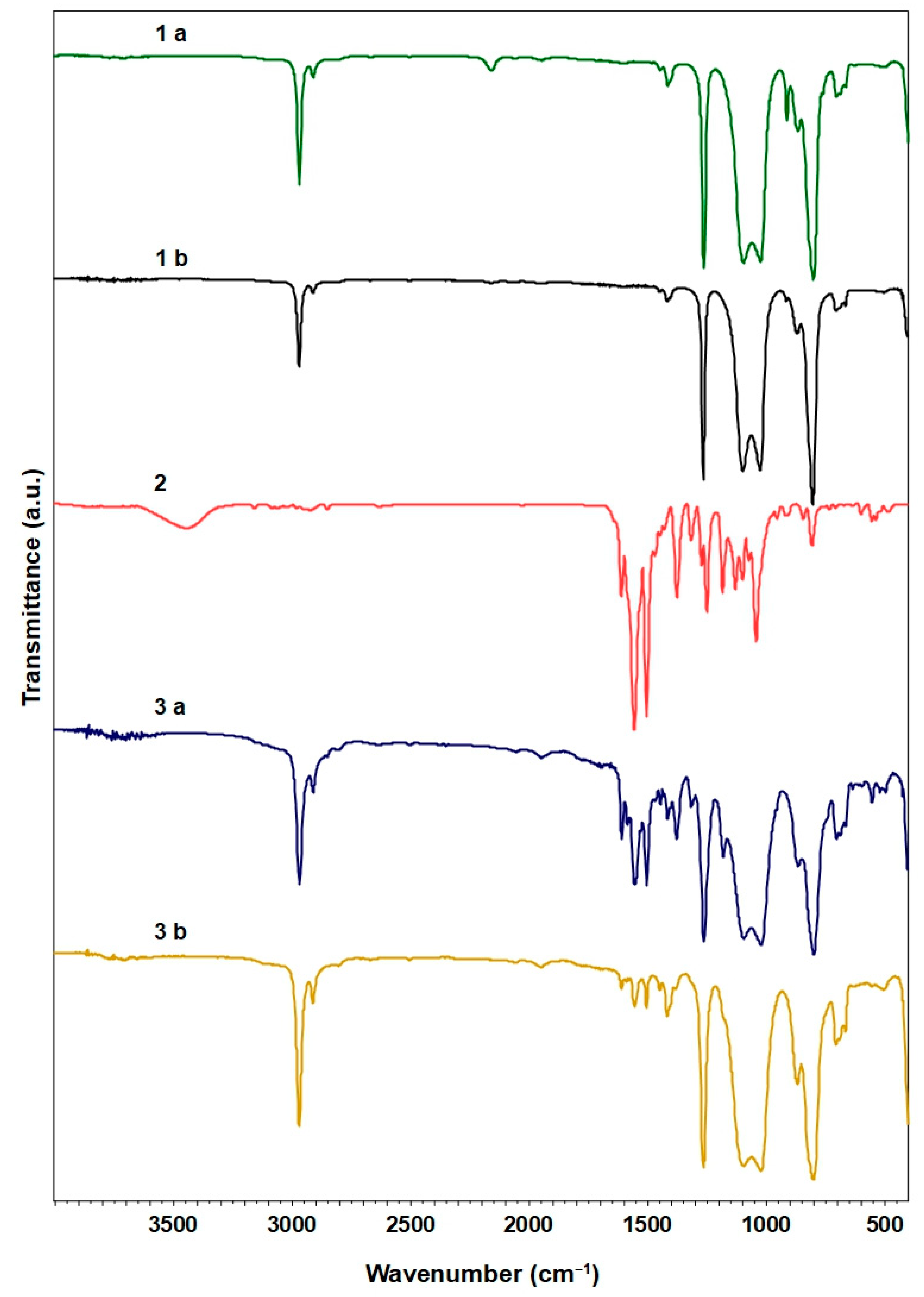



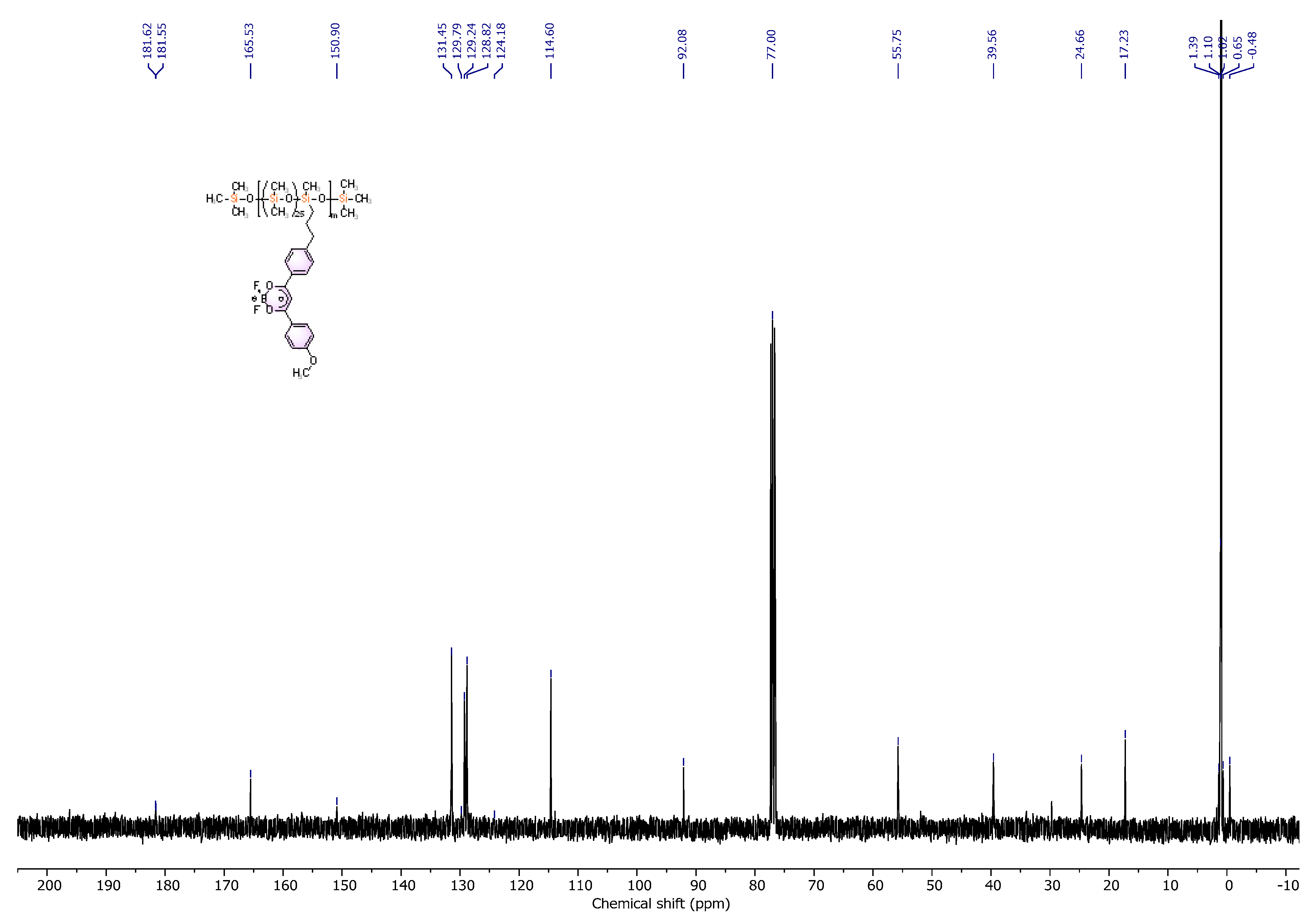

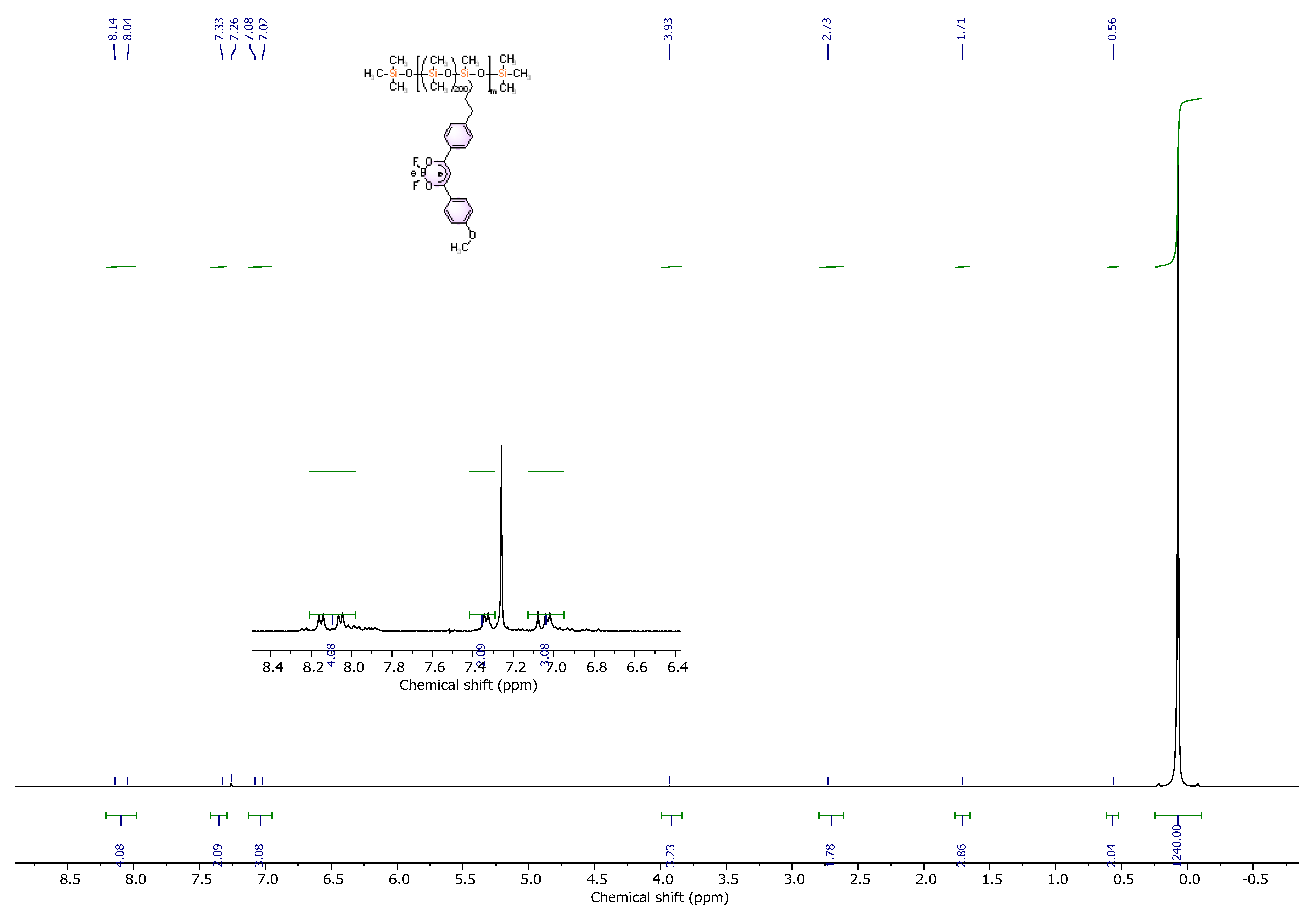
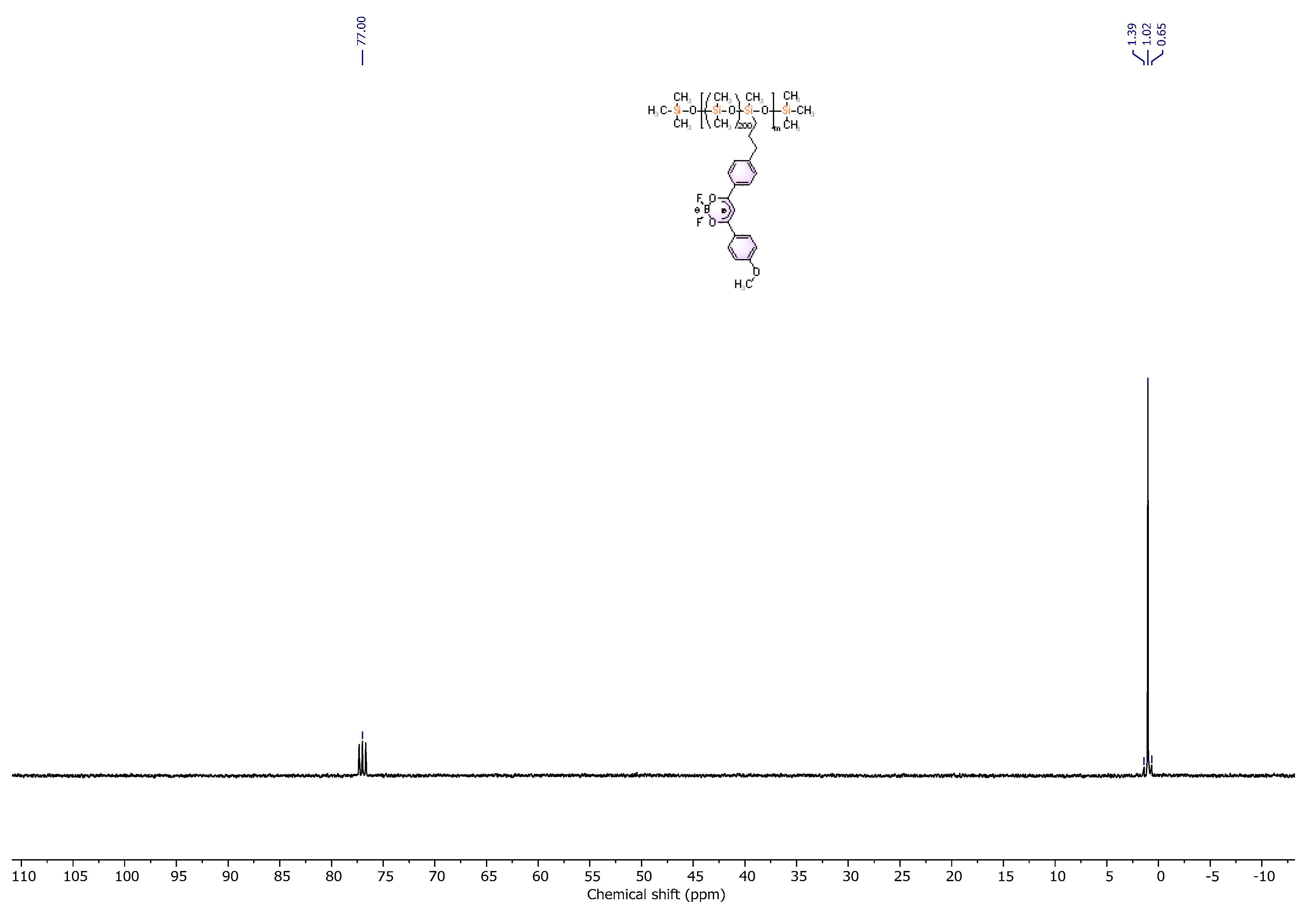
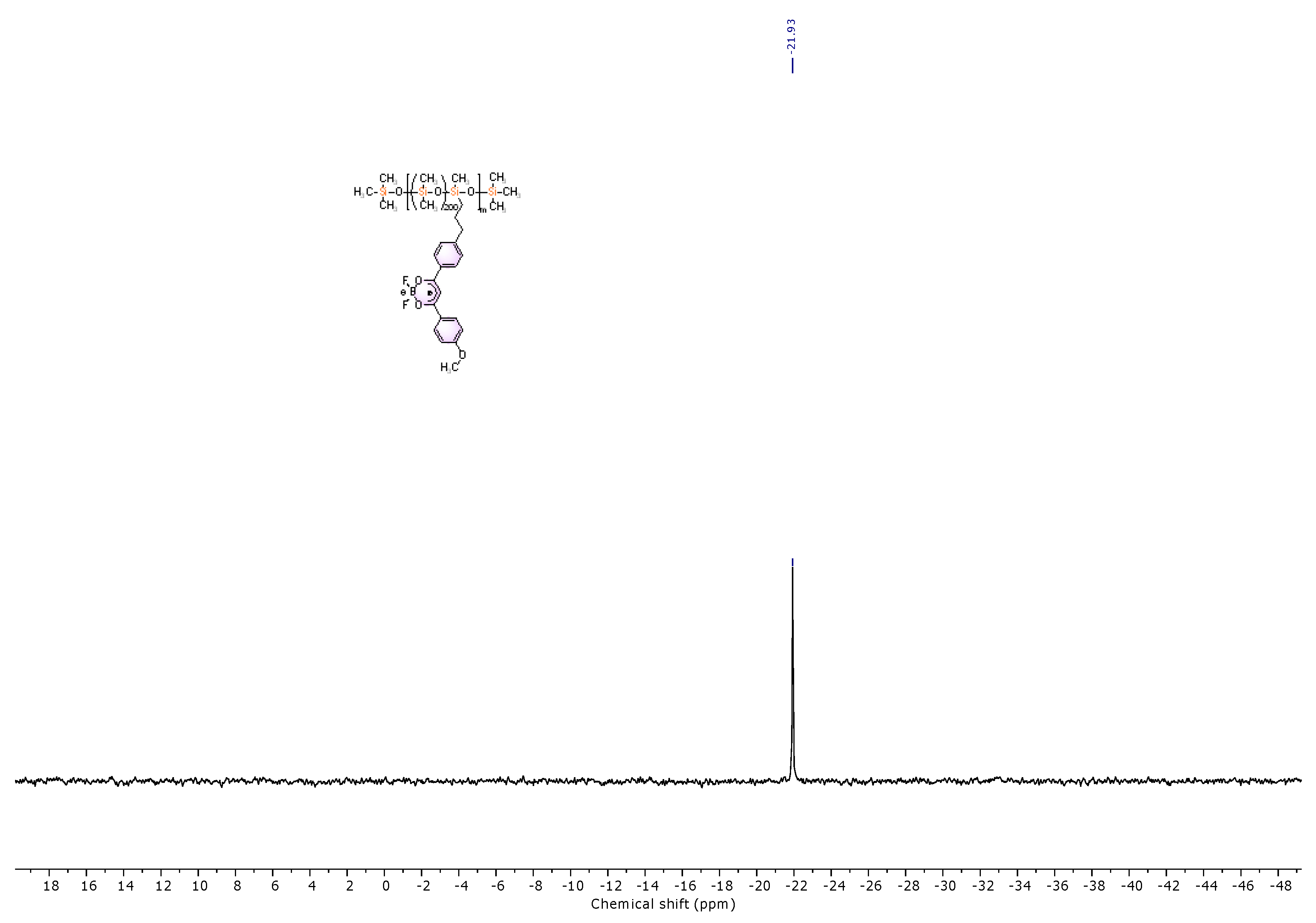

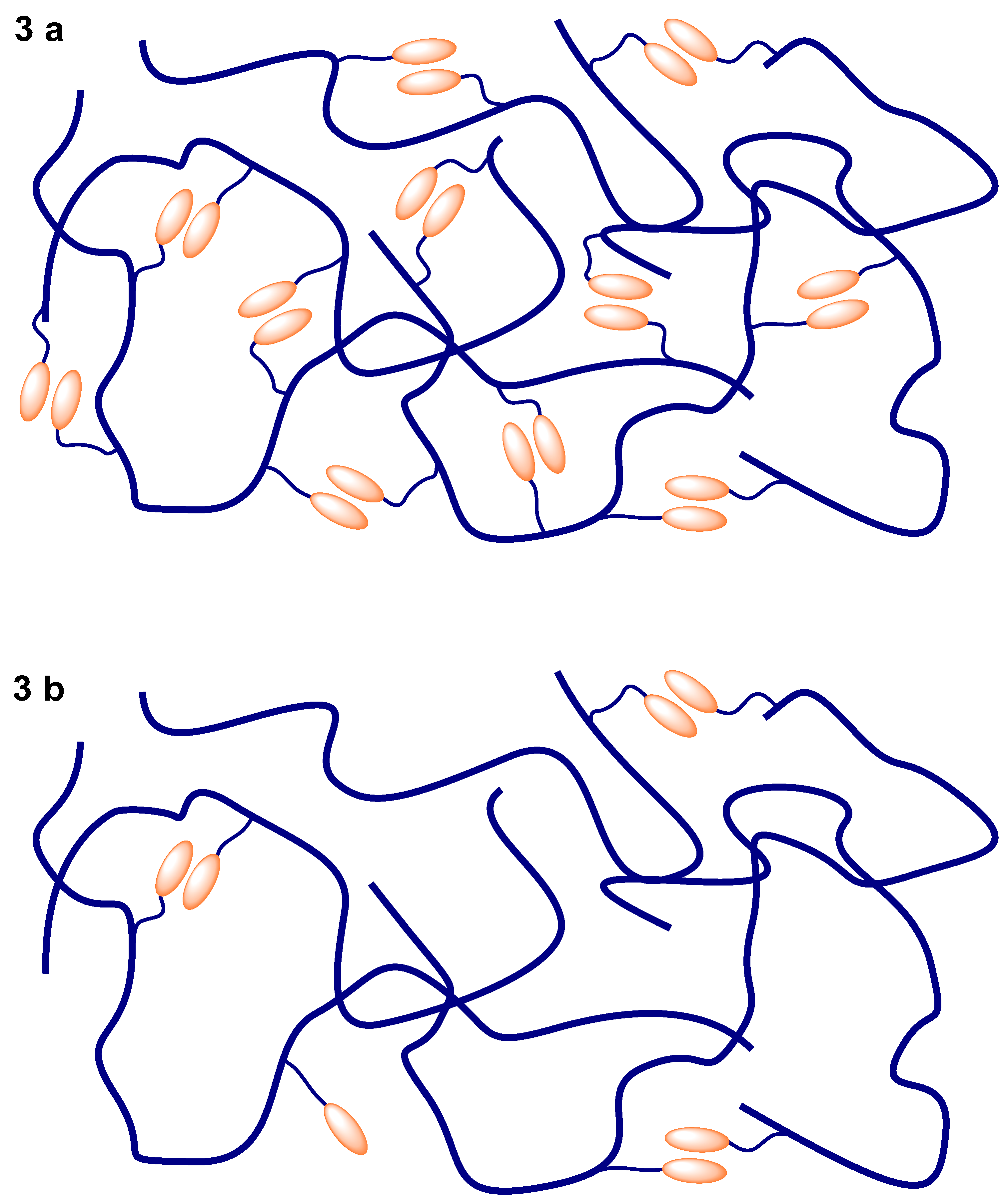

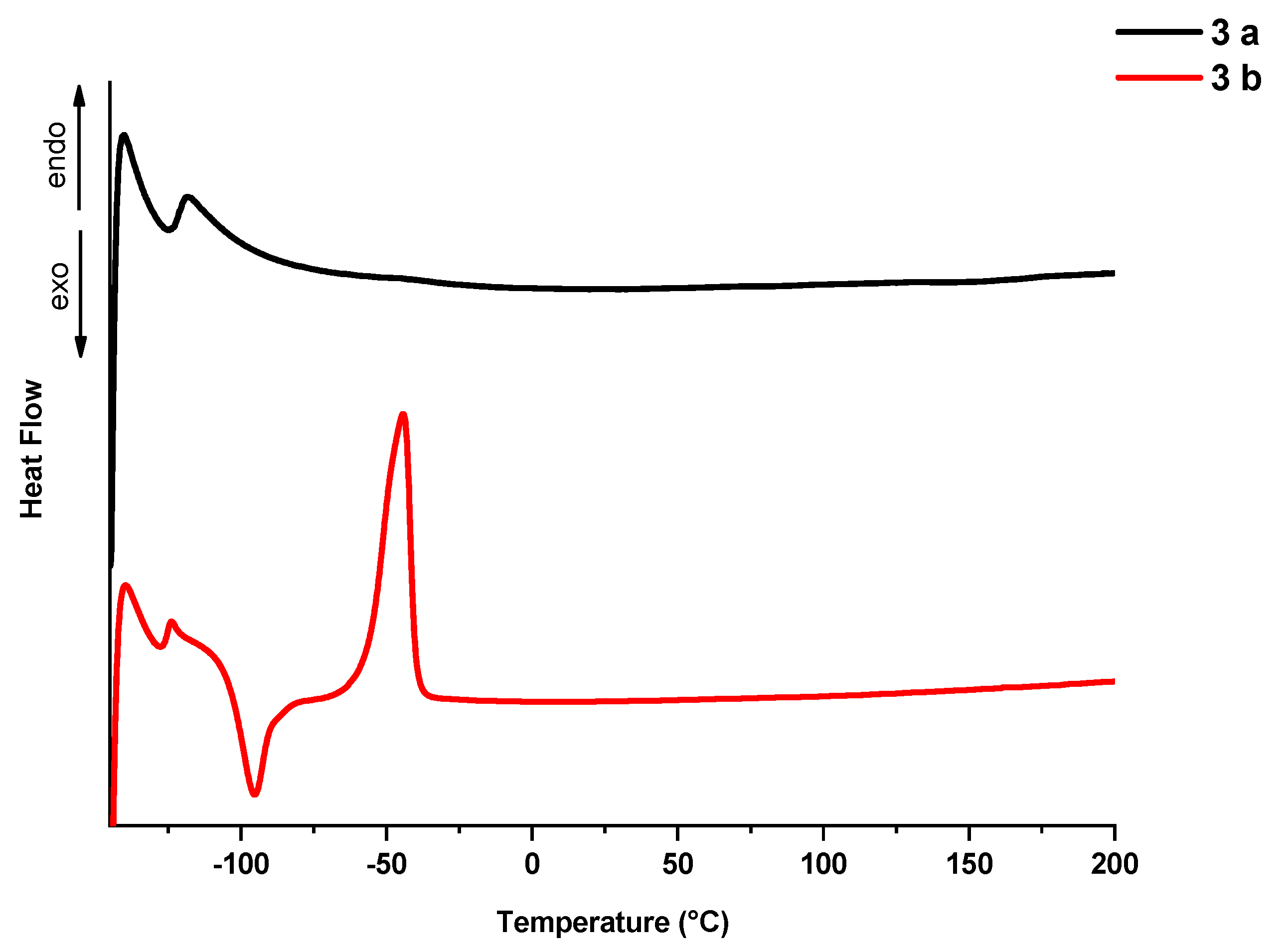
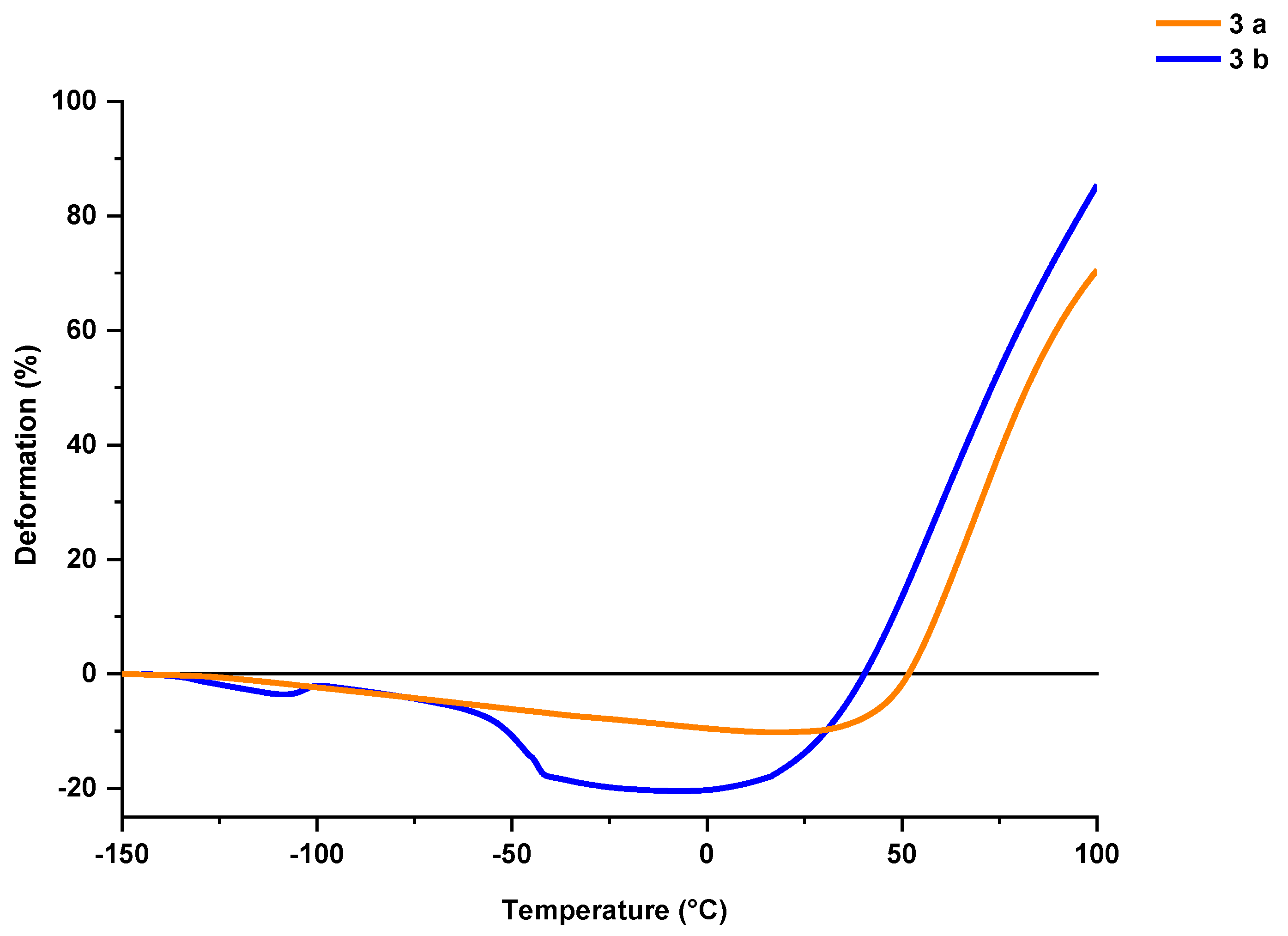

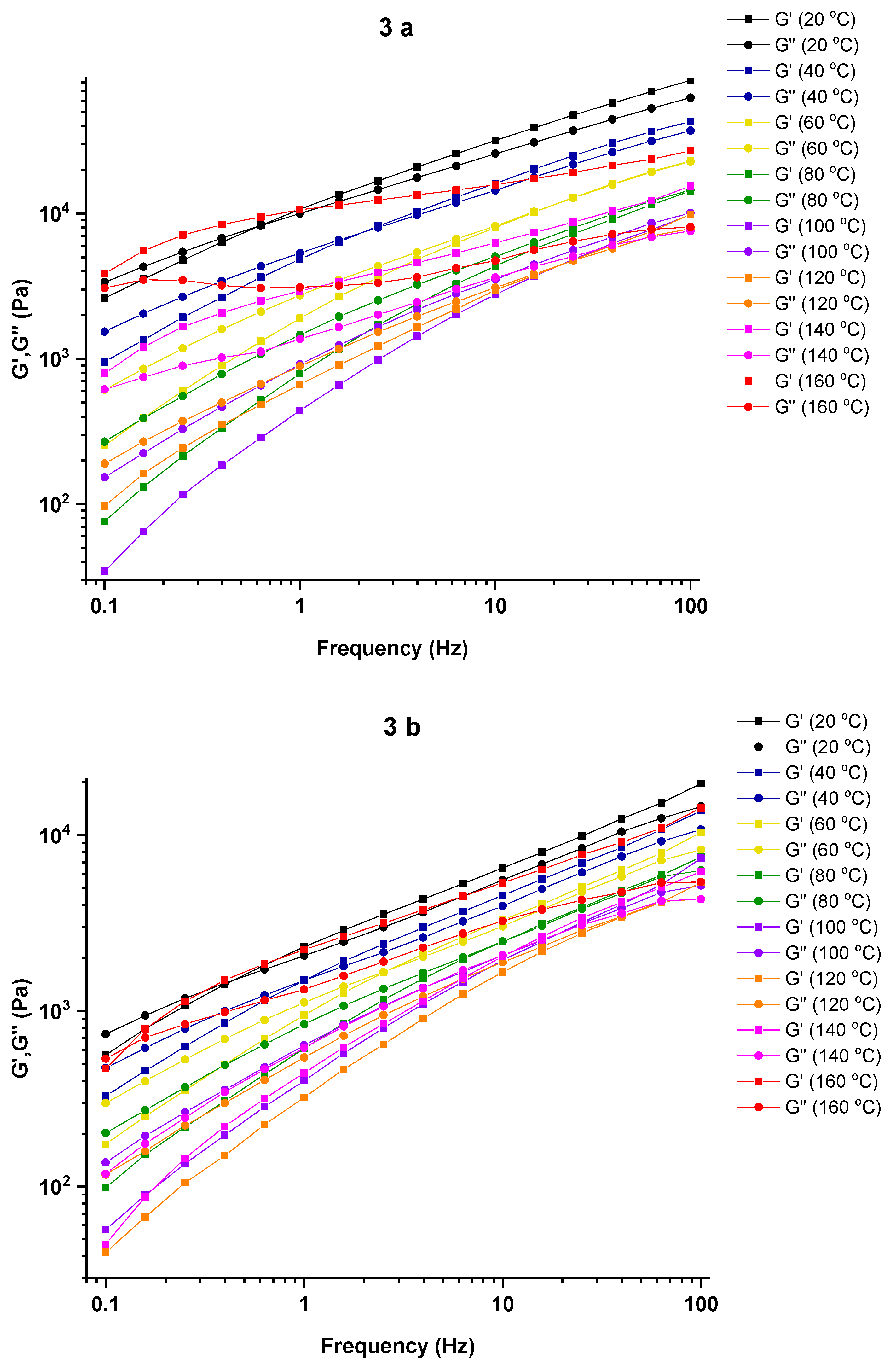
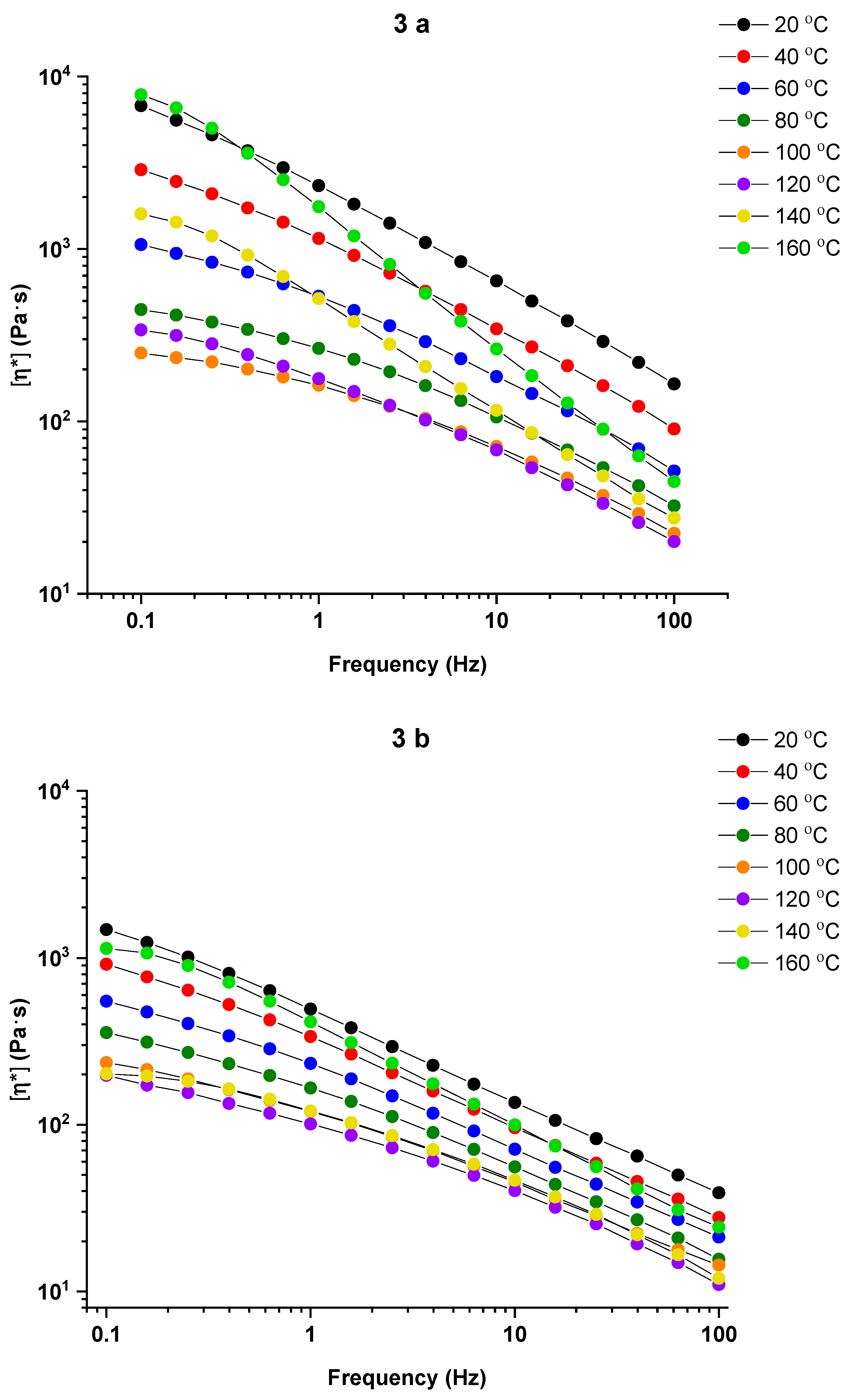
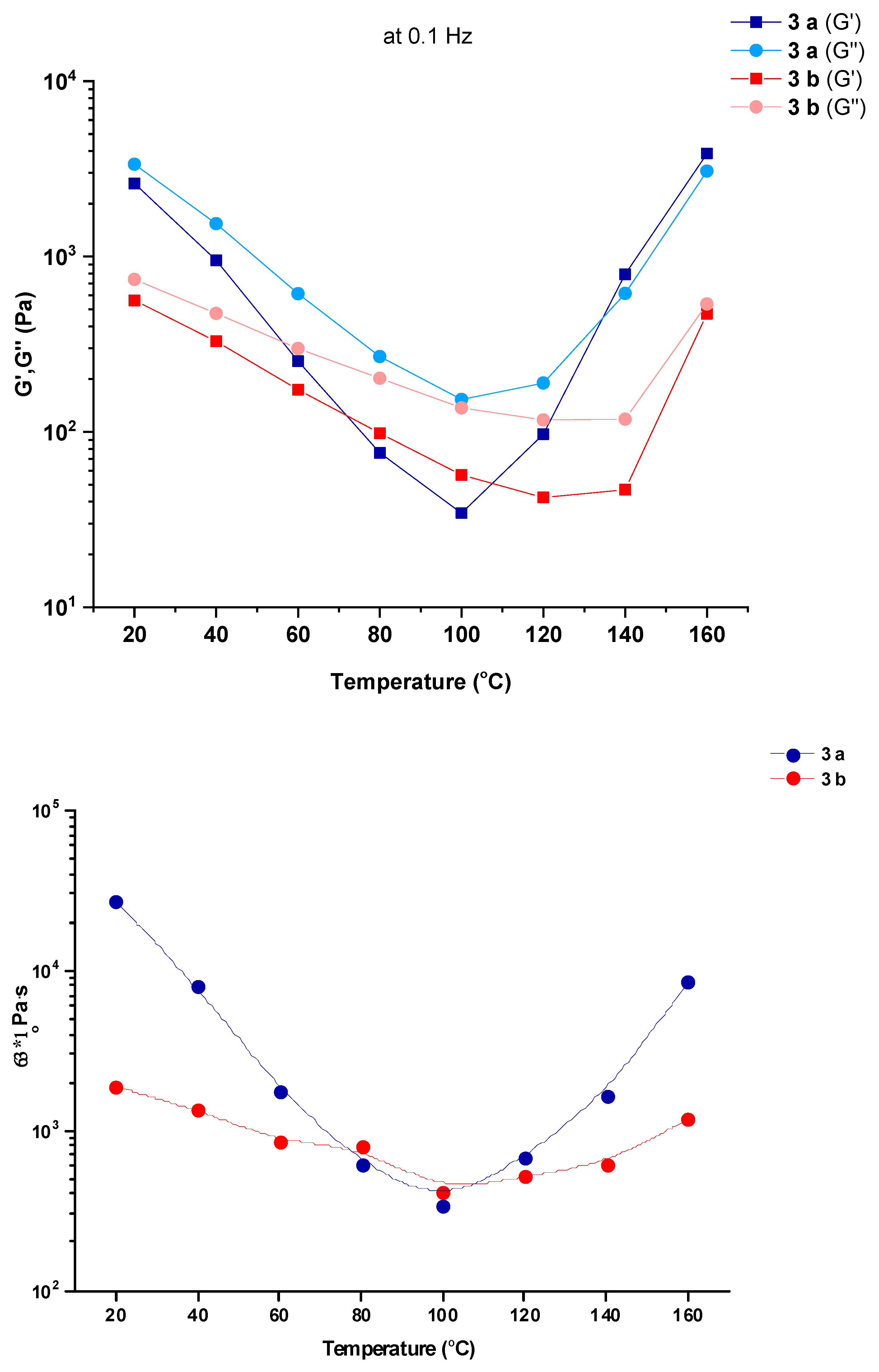
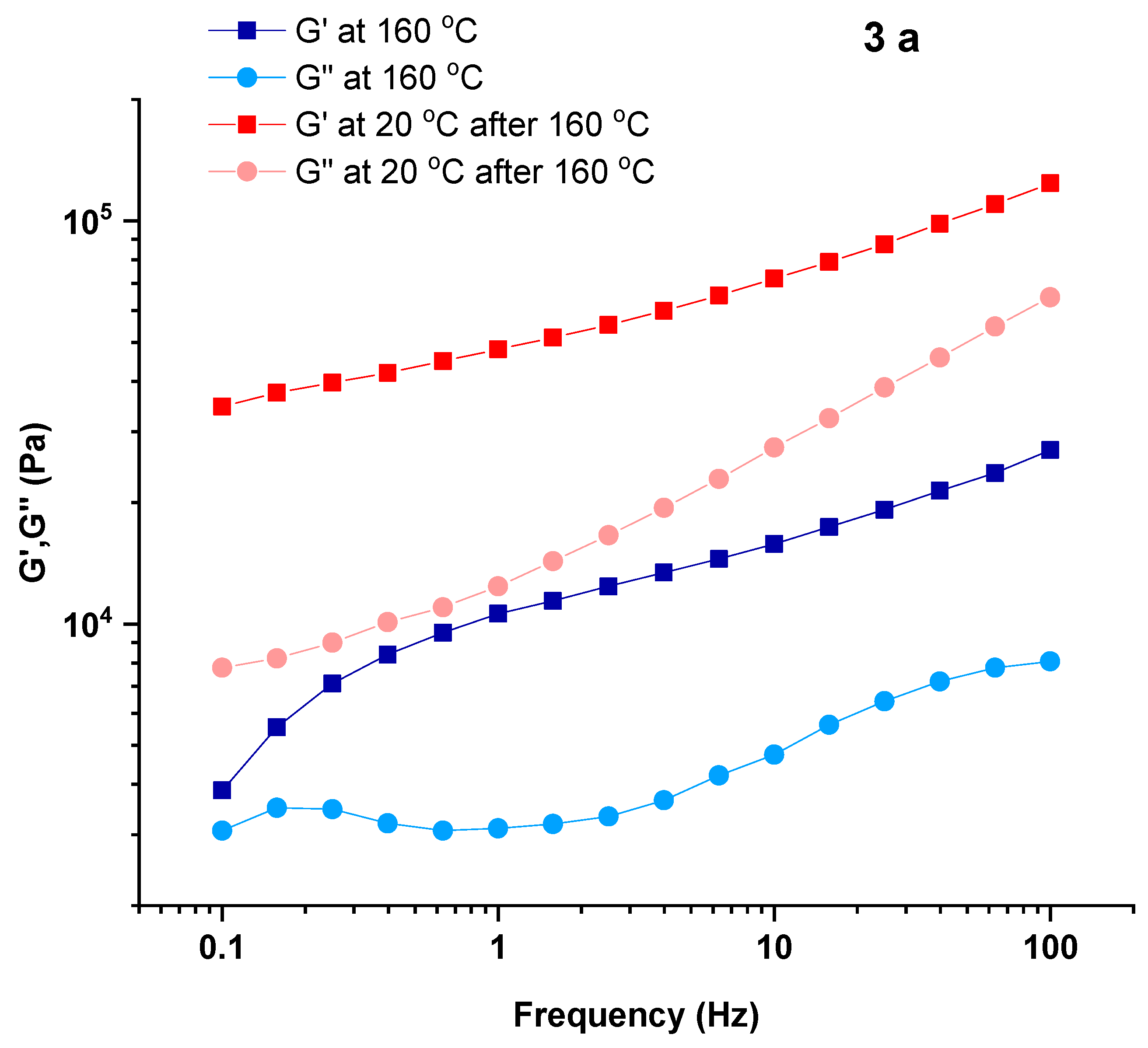
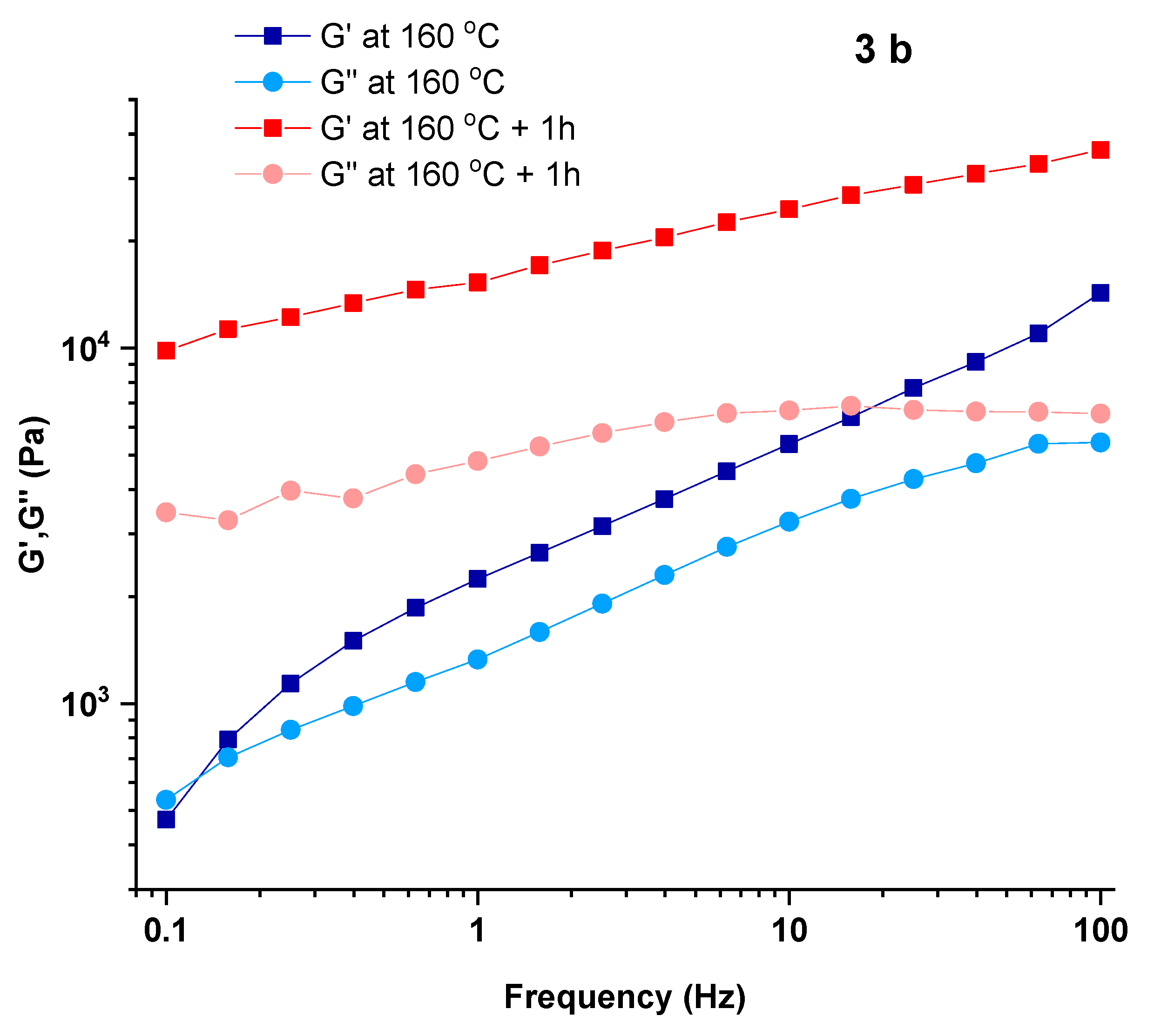


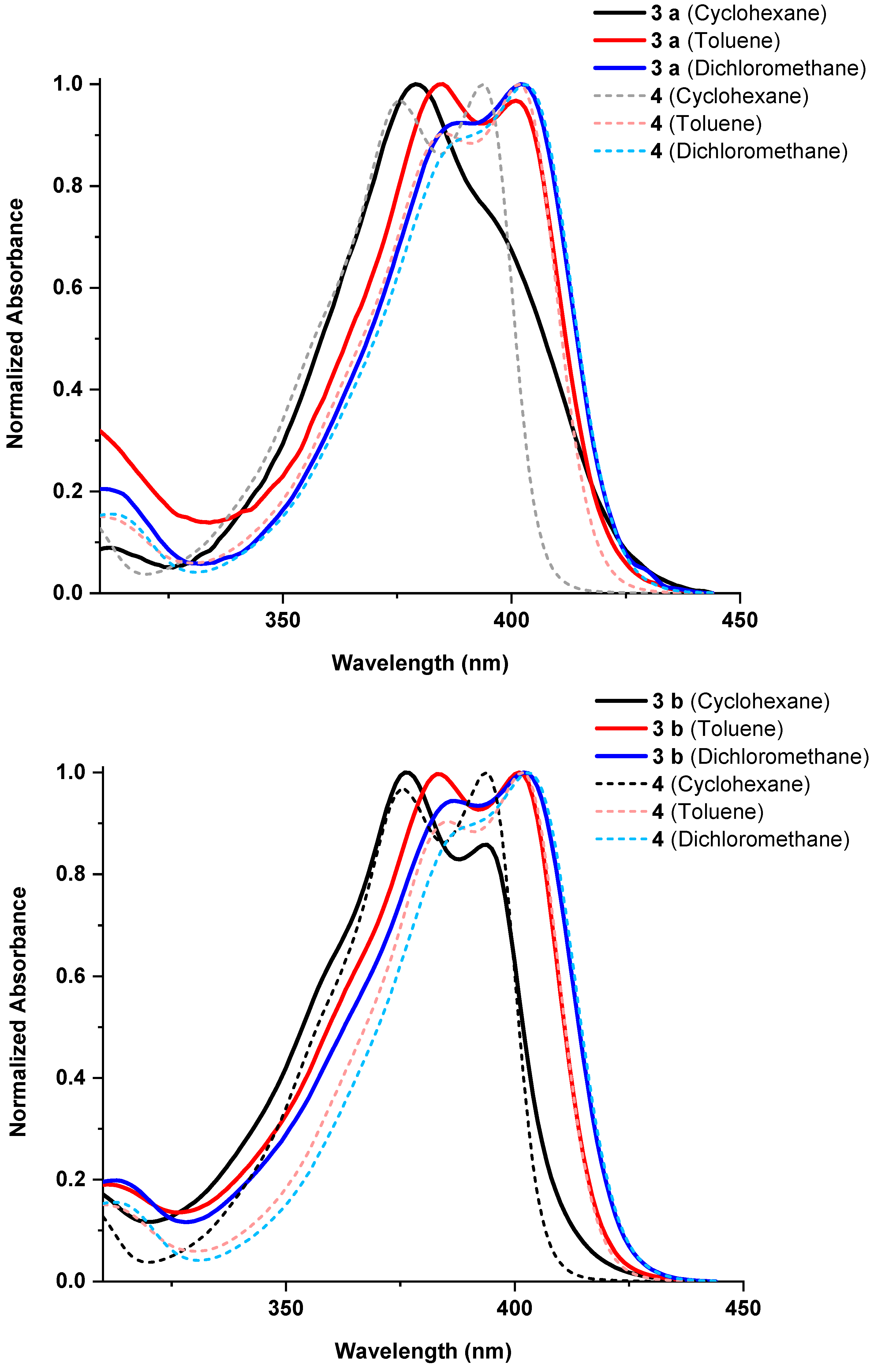


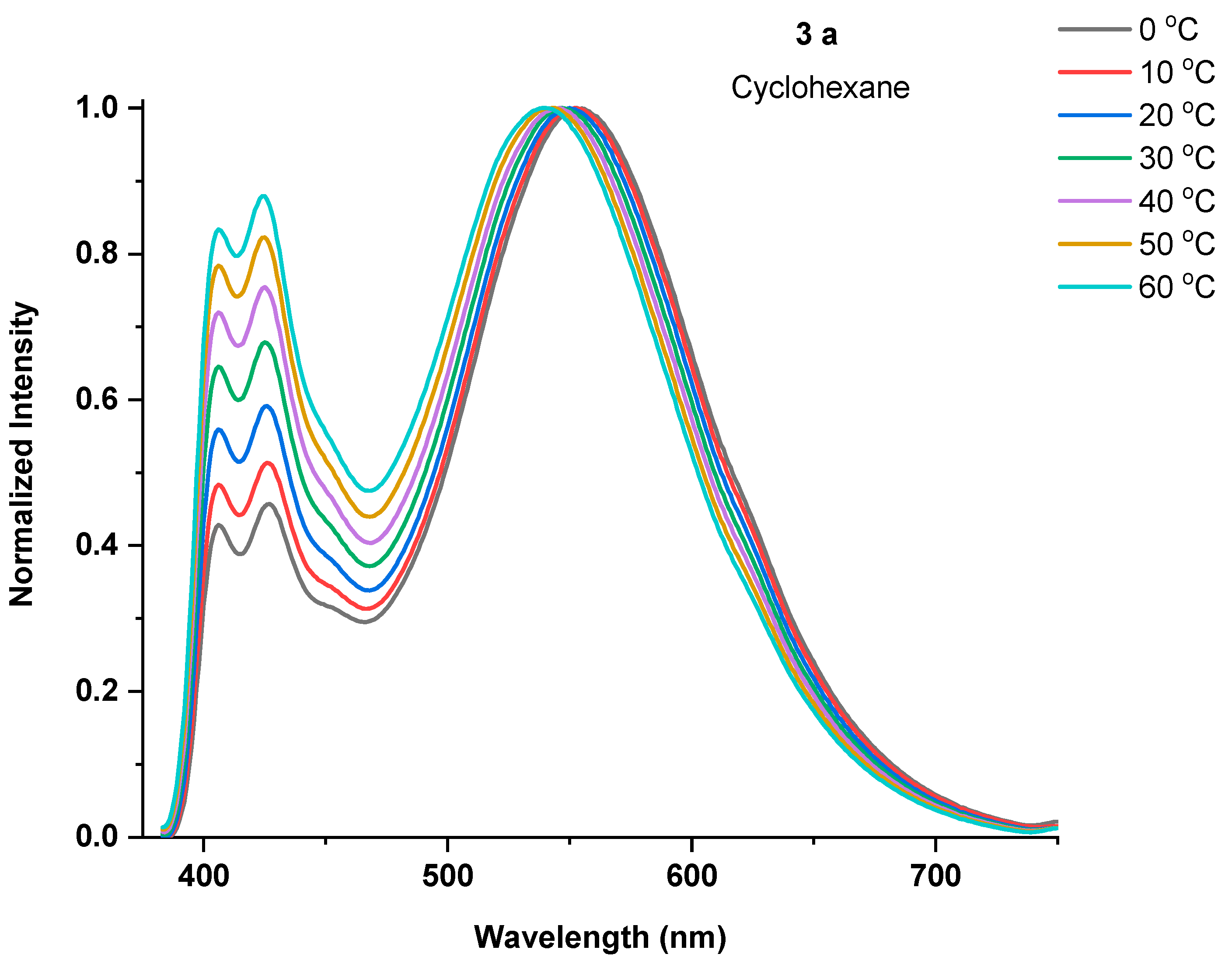
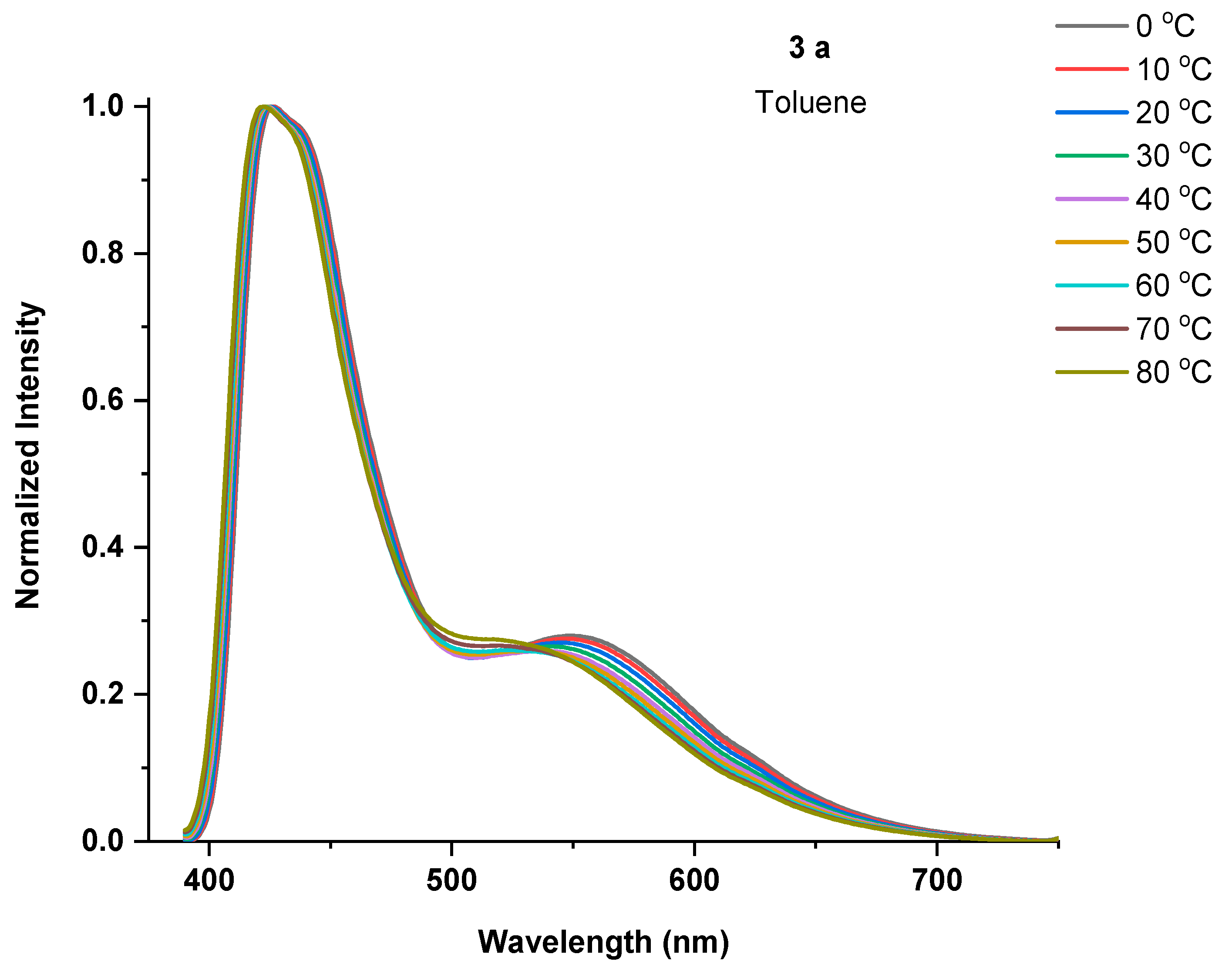

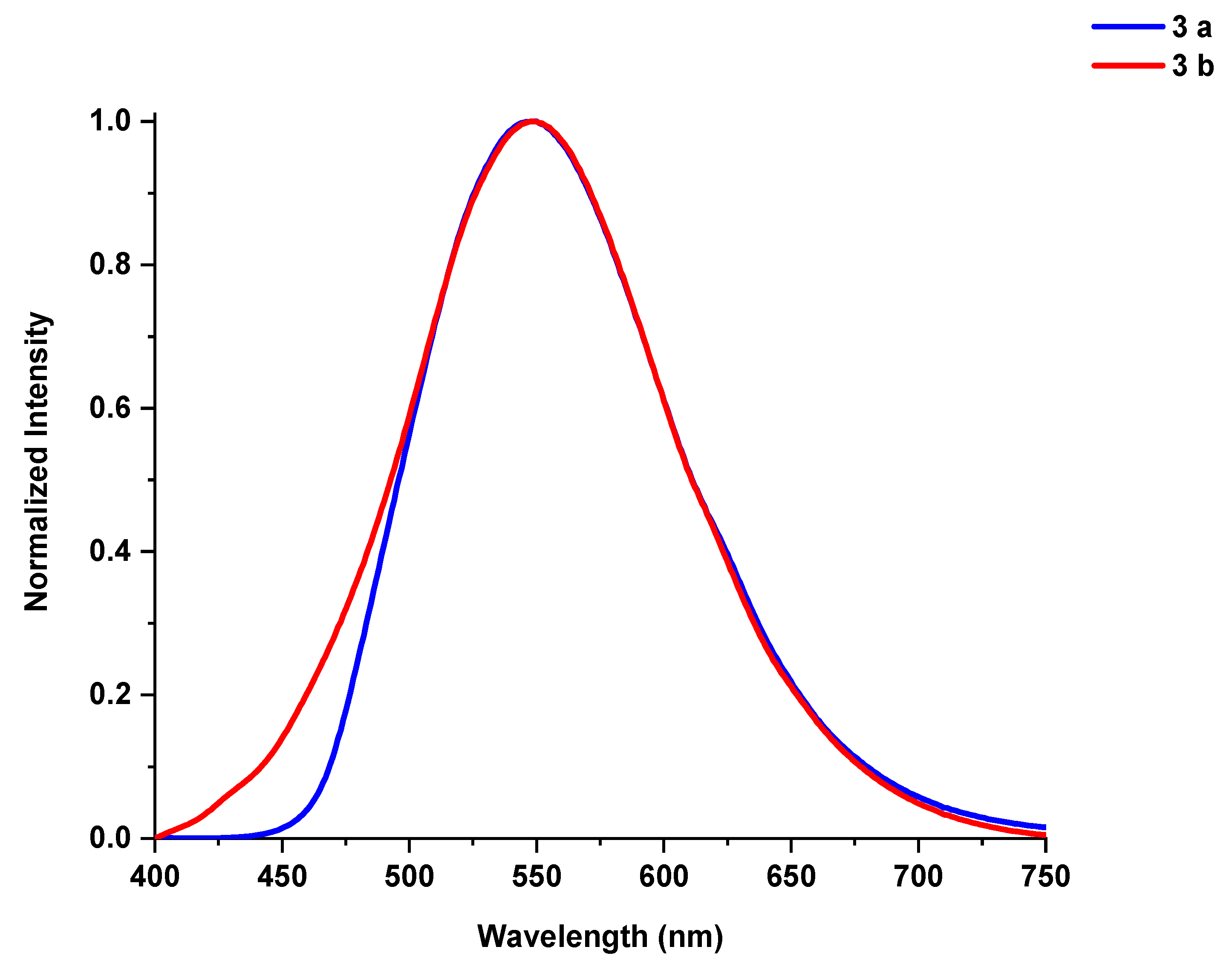
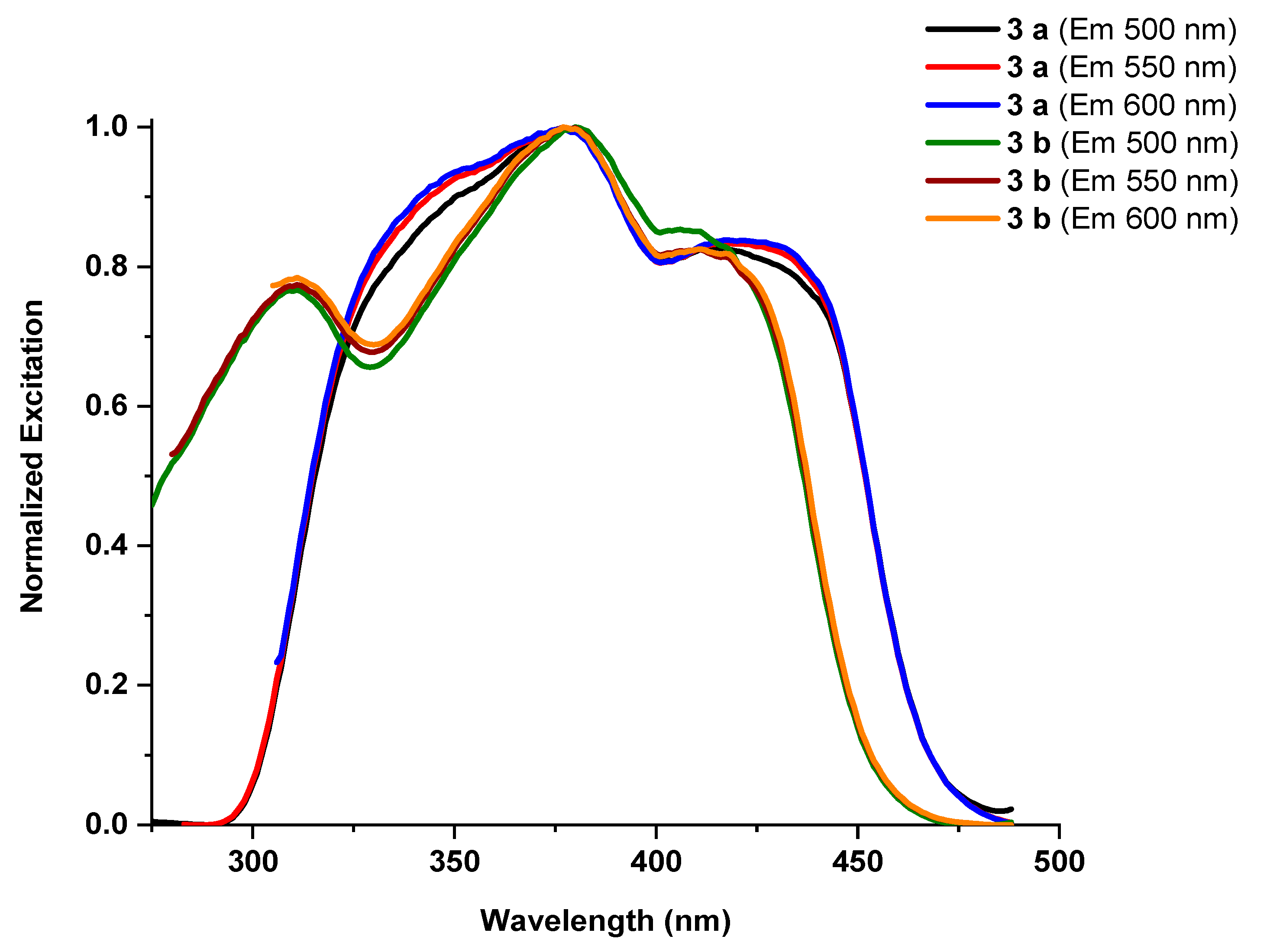


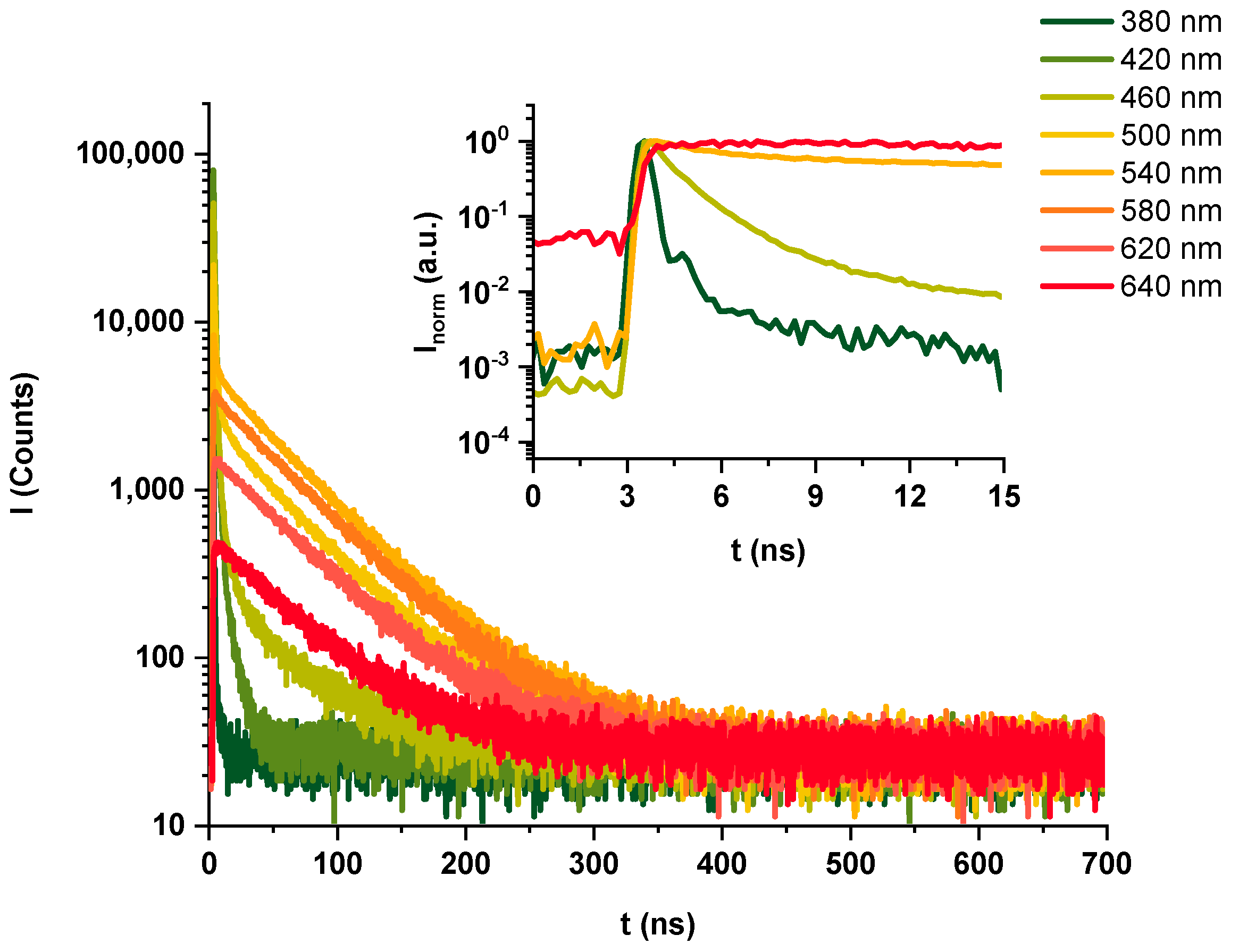
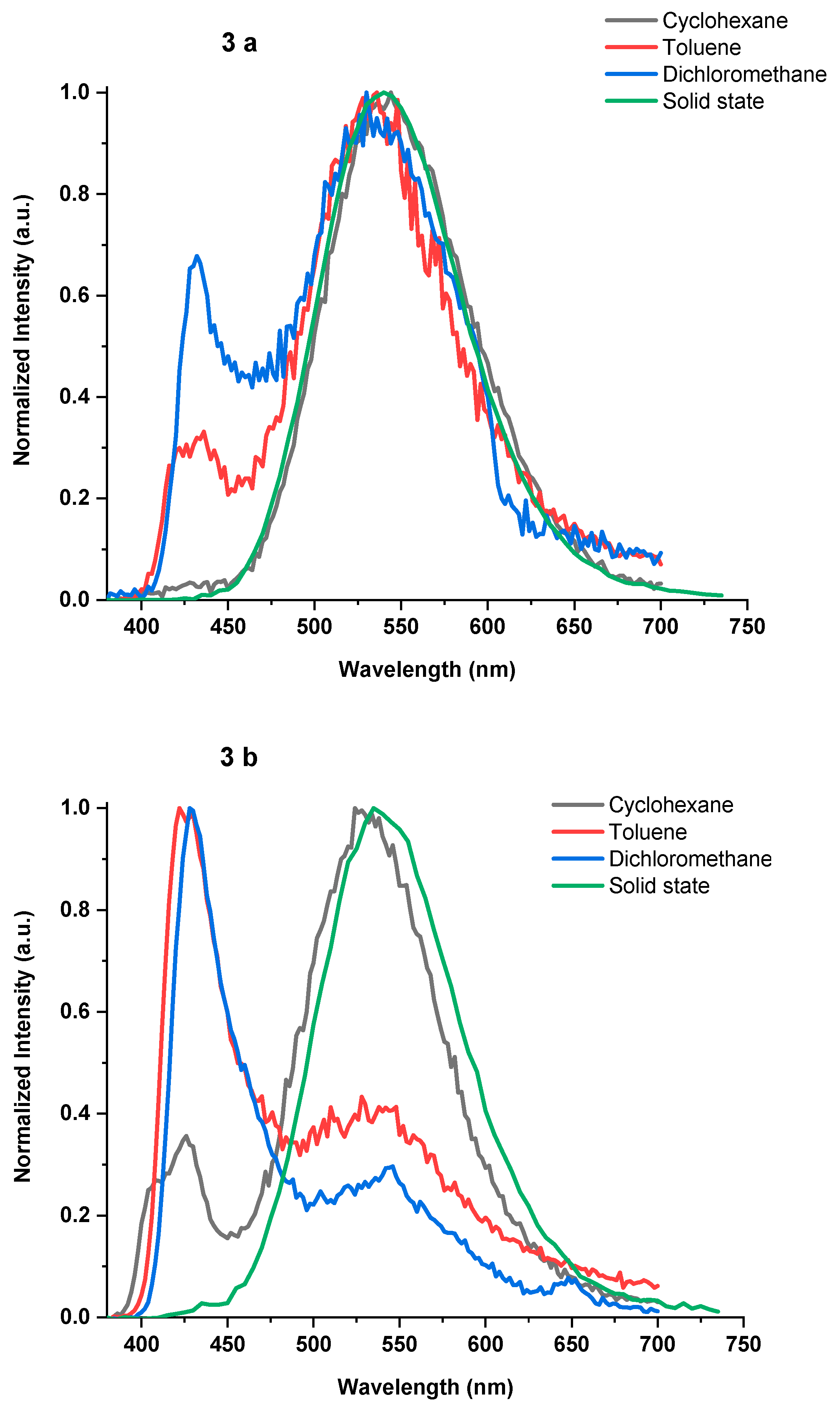
| Compound | Td5% a (°C) | Residue after Decomp in Air (%) | Tg b,c (°C) | Tcc (°C) | ΔHcc (J/g) | Tm (°C) | ΔHm (J/g) | ||
|---|---|---|---|---|---|---|---|---|---|
| in Air | in Argon | in Air | in Argon | ||||||
| 1 a | 382 | 398 | 17 | 2 | n | n | n | n | n |
| 1 b | 383 | 404 | 10 | 0 | n | n | n | n | n |
| 3 a | 323 | 347 | 19 | 4 | −121 | - | - | - | - |
| 3 b | 393 | 413 | 5 | 4 | −125 | −95 | 12 | −44 | 25 |
| Compound | Solvent | λabs (nm) | ε (M−1 cm−1) | λem a (nm) | Φf b | Iex/Im c |
|---|---|---|---|---|---|---|
| 3 a | Cyclohexane | 379 | - | 406, 426 (m) 550 (e) | 0.28 | 2.28 |
| Toluene | 401, 385 | - | 424 (m) 550 (e) | 0.44 | 0.30 | |
| Dichloromethane | 403, 387 | - | 430 (m) 550 (e) | 0.60 | 0.12 | |
| 3 b | Cyclohexane | 394, 376 | - | 405, 425 (m) 550 (e) | 0.50 | 0.06 |
| Toluene | 401, 383 | - | 422 (m) | 0.73 | 0.02 | |
| Dichloromethane | 402, 386 | - | 429 (m) | 0.73 | 0.01 | |
| 4 | Cyclohexane | 394, 376 | 60,700 | 405, 425 (m) | 0.82 | - |
| Toluene | 402, 385 | 54,400 | 422 (m) | 0.87 | - | |
| Dichloromethane | 403, 388 | 65,200 | 430 (m) | 0.87 | - |
| Compound | Solvent | T (°C) | Iex/Im |
|---|---|---|---|
| 3 a | Cyclohexane | 0 | 2.335 |
| 10 | 2.068 | ||
| 20 | 1.788 | ||
| 30 | 1.55 | ||
| 40 | 1.389 | ||
| 50 | 1.276 | ||
| 60 | 1.2 | ||
| Toluene | 0 | 0.278 | |
| 10 | 0.276 | ||
| 20 | 0.269 | ||
| 30 | 0.262 | ||
| 40 | 0.254 | ||
| 50 | 0.25 | ||
| 60 | 0.245 | ||
| 70 | 0.244 | ||
| 80 | 0.244 |
| Polymer | Solvent | τ1 (ns) | τ2 (ns) | τ3 (ns) | τ4 (ns) |
|---|---|---|---|---|---|
| 3 a | Cyclohexane | 0.16 | 1.1 | 6.18 | 56.0 |
| Toluene | 0.52 | 1.39 | 10.9 | 48.5 | |
| Dichloromethane | 0.23 | 1.26 | 3.53 | 52.5 | |
| 3 b | Cyclohexane | 0.27 | 1.45 | 7.65 | 55.3 |
| Toluene | 0.44 | 1.84 | 10.85 | 54 | |
| Dichloromethane | 0.18 | 1.7 | 6.5 | 51.1 |
| Polymer | Solvent | τ (μs) | A (%) |
|---|---|---|---|
| 3 a | Solid state | 15,800 | 15 |
| 5600 | 28 | ||
| 570 | 57 | ||
| Cyclohexane | 44 | 16 | |
| 9 | 84 | ||
| Toluene | 51 | 13 | |
| 8 | 88 | ||
| Dichloromethane | 68 | 57 | |
| 14 | 43 | ||
| 3 b | Solid state | 15,800 | 38 |
| 4000 | 62 | ||
| Cyclohexane | 142 | 30 | |
| 31 | 70 | ||
| Toluene | 96 | 33 | |
| 15 | 67 | ||
| Dichloromethane | 64 | 20 | |
| 10 | 80 |
Publisher’s Note: MDPI stays neutral with regard to jurisdictional claims in published maps and institutional affiliations. |
© 2022 by the authors. Licensee MDPI, Basel, Switzerland. This article is an open access article distributed under the terms and conditions of the Creative Commons Attribution (CC BY) license (https://creativecommons.org/licenses/by/4.0/).
Share and Cite
Belova, A.S.; Khchoyan, A.G.; Il’ina, T.M.; Kononevich, Y.N.; Ionov, D.S.; Sazhnikov, V.A.; Khanin, D.A.; Nikiforova, G.G.; Vasil’ev, V.G.; Muzafarov, A.M. Polydimethylsiloxanes with Grafted Dibenzoylmethanatoboron Difluoride: Synthesis and Properties. Polymers 2022, 14, 5075. https://doi.org/10.3390/polym14235075
Belova AS, Khchoyan AG, Il’ina TM, Kononevich YN, Ionov DS, Sazhnikov VA, Khanin DA, Nikiforova GG, Vasil’ev VG, Muzafarov AM. Polydimethylsiloxanes with Grafted Dibenzoylmethanatoboron Difluoride: Synthesis and Properties. Polymers. 2022; 14(23):5075. https://doi.org/10.3390/polym14235075
Chicago/Turabian StyleBelova, Anastasia S., Arevik G. Khchoyan, Tatiana M. Il’ina, Yuriy N. Kononevich, Dmitry S. Ionov, Viacheslav A. Sazhnikov, Dmitry A. Khanin, Galina G. Nikiforova, Viktor G. Vasil’ev, and Aziz M. Muzafarov. 2022. "Polydimethylsiloxanes with Grafted Dibenzoylmethanatoboron Difluoride: Synthesis and Properties" Polymers 14, no. 23: 5075. https://doi.org/10.3390/polym14235075





